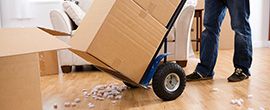A Stress-Free Approach to Moving Your Bed and Mattress
Posted on 09/06/2025
A Stress-Free Approach to Moving Your Bed and Mattress
Moving to a new home can be both an exciting and overwhelming process. Among the many items that require special attention during a move, the bed and mattress stand out. Ensuring these crucial pieces arrive safely and comfortably is vital for a smooth transition. In this comprehensive guide, you'll discover a stress-free approach to moving your bed and mattress, filled with expert tips, step-by-step instructions, and essential insights to safeguard your comfort and peace of mind.

Why Moving Your Bed and Mattress Can Be Challenging
The average mattress weighs between 50-150 pounds, and bed frames can be bulky or fragile, making relocation somewhat tricky. Aside from the physical weight, beds and mattresses are designed for comfort, not durability, when it comes to transport. Moving them improperly can lead to damage, hygiene issues, or even injuries.
- Size and Weight: Many mattresses are large and awkward, particularly king and queen sizes.
- Protecting Cleanliness: Mattresses easily pick up dust, dirt, and stains.
- Preventing Damage: Fragile slats or intricate headboards can snap or scratch.
- Disassembly Complexity: Some modern bed frames require tools and patience to disassemble and reassemble.
Preparing with the right knowledge and tools is key to a seamless moving experience.
Plan Ahead: Preparation Is Key
1. Gather Moving Supplies
Before you even think about moving your bed and mattress, collecting the right supplies will make the entire process much easier. Make sure you have:
- Mattress bags (for all sizes)
- Furniture blankets or plastic wrap
- Bubble wrap or padding for bed components
- Screwdrivers, Allan wrenches, or specialized tools
- Moving straps or carrying harnesses
- Sturdy boxes for bolts, screws, and small parts
- Painter's tape and permanent markers for labeling
Tip: Order mattress covers online or purchase them from local moving supply stores. These help protect your mattress from dirt, moisture, and tears.
2. Clean and Prepare Your Mattress
Before moving, give your mattress a thorough cleaning:
- Vacuum all sides using an upholstery attachment to remove dust and allergens.
- Spot-clean any stains with mild detergent and let it dry completely.
- Allow your mattress time to air out for a few hours. This will help eliminate odors and moisture.
3. Disassemble the Bed Frame
Most beds are best moved in parts. If your bed can be disassembled, follow these steps:
- Remove all pillows, sheets, and bedding.
- Take clear photos of the assembled bed for reference later.
- Organize all nuts, bolts, and small parts in labeled bags or containers.
- Keep structural pieces, such as headboards and footboards, wrapped in blankets or bubble wrap for protection.
Careful labeling and photo documentation ensure reassembly is hassle-free at your new home.
The Step-by-Step Stress-Free Bed and Mattress Moving Process
Step 1: Protect the Mattress
The heart of moving your bed and mattress stress-free lies in protection. Use a mattress moving cover (available in most home goods or hardware stores). These are waterproof, tear-resistant, and designed to seal the entire mattress.
For added peace of mind, use moving blankets or additional plastic wrap for extra cushioning, especially for memory foam or latex mattresses that are sensitive to sharp bumps.
Step 2: Disassemble Bed Frame Properly
Disassemble your bed frame by following the manufacturer's instructions or using the photos you took earlier for reference. Pay special attention to delicate wooden or metal frames.
- Remove rails by loosening side bolts with the correct tool.
- Take off slats and store them flat to prevent warping.
- Wrap legs and small pieces with bubble wrap or towels.
Pro tip: Tape sealed, labeled bags containing nuts and bolts to the frame pieces so they don't get lost.
Step 3: Safe Lifting and Transportation
- Use proper lifting techniques; bend at the knees, keep your back straight, and avoid twisting motions.
- Never drag your mattress or bed frame across the floor--this can cause structural and cosmetic damage.
- Enlist help; beds and mattresses often require two people to carry safely.
If using a professional moving company, verify that they are experienced in handling and packing beds and mattresses specifically. If moving on your own, use a dolly or hand truck when possible to reduce the risk of injury.
Step 4: Loading Into the Moving Vehicle
- Place the mattress flat (on its side only if flat space isn't available) to minimize sagging or damage, especially for memory foam and hybrid mattresses.
- Slide bed frame pieces along the sides of the truck for stability.
- Secure all items with moving straps to avoid shifting during transport.
Stress-Free Mattress and Bed Unloading and Reassembly
The final step to your stress-free mattress move is setting up your sleep sanctuary in your new home as soon as possible. A good night's rest is invaluable after a long day of moving!
1. Unload with Care
- Enlist help to manage large or awkward pieces.
- Check for any potential damage that may have occurred during transit.
- Allow the mattress to air out again, especially if it's been in a plastic cover for a prolonged period.
2. Reassemble the Bed Frame
- Refer to your earlier photos and labeled parts for guidance.
- Assemble the frame in the designated bedroom before placing the mattress on top.
- Tighten all screws and connections securely to avoid squeaking or movement.
3. Final Mattress Placement
- Remove the protective cover gently to avoid ripping or snagging the mattress fabric.
- Inspect for dust, stains, or odors; spot-clean if necessary.
- Let the mattress decompress fully before use (especially if it's memory foam or latex).
Special Tips for Moving Different Types of Beds and Mattresses
Memory Foam and Latex Mattresses
- These mattresses are heavy and flexible, so always move them flat when possible.
- Avoid folding or bending, which can damage the foam structure.
- Store in a climate-controlled environment during the move to prevent damage from extreme temperatures.
Spring and Hybrid Mattresses
- Can be transported upright for short distances, but avoid prolonged pressure to prevent deformation of springs.
- Protect edges from being crushed by heavier items in the moving vehicle.
Adjustable Bed Bases
- Always disassemble electronics and remove batteries, if applicable.
- Pack electrical components separately, labeling them carefully.
- Wrap the base in padded blankets to protect motors and moving parts.
Antique or Specialty Beds
- Wrap delicate wood or ornate carvings in sturdy moving blankets.
- Consider hiring professional movers if your bed is particularly valuable or fragile.
Should You Move Your Mattress or Buy a New One?
While a stress-free mattress move is possible, there are times when transporting your mattress may not be the best option:
- Age and condition: If your mattress is over 7-10 years old or shows signs of wear, consider replacing it.
- Travel distance: For long-distance relocations, especially cross-country, mattress damage risk increases.
- Space constraints: Measure doorways and staircases to ensure your mattress fits in the new space.
If it makes more sense to purchase a new mattress, schedule delivery for soon after your move-in date, so you're not left without a bed.
Hiring Professional Mattress and Bed Movers
If you prefer to avoid the hassle or have valuable or bulky bedroom furniture, hiring professional movers can be a stress-free solution. Here's what to look for:
- Experience moving large or specialty beds and mattresses
- License and insurance coverage
- Positive client testimonials
- Specialized equipment (dollies, moving straps, mattress protectors)
Always get a quote in advance and discuss all details about your specific bed and mattress moving needs.

Maintaining a Stress-Free Moving Mentality
The secret ingredient to a successful move isn't just packing skills--it's your mindset. Take these steps to reduce anxiety as you follow this stress-free process:
- Start early--avoid last-minute rushing by prepping your bedroom furniture in advance.
- Enlist help--friends, family, or professional movers can make a world of difference.
- Stay organized--labeled bags and strategic packing mean you'll find everything easily at your new home.
- Plan for rest--prioritize reassembling your bed and mattress so you can recharge after a long moving day.
Moving your bed and mattress doesn't have to be daunting. With careful planning, the right tools, and a calm mindset, you'll ensure your journey--and your sleep--is smooth and stress-free.
Conclusion: Your Blueprint for a Stress-Free Bed and Mattress Move
Now you have a complete, step-by-step, stress-free guide to moving your bed and mattress. Whether you're tackling a relocation yourself or working with pros, following these strategic tips minimizes frustration and maximizes comfort. Remember: protect your mattress with the right supplies, disassemble carefully, transport thoughtfully, and set up your sleep space as a top priority in your new home.
With this comprehensive approach, your first night in your new bedroom will be truly restful--setting the stage for a positive new chapter ahead.
- Start your move with confidence and peace of mind.
- A stress-free bed and mattress move is within your reach--rest easy as you settle in!






